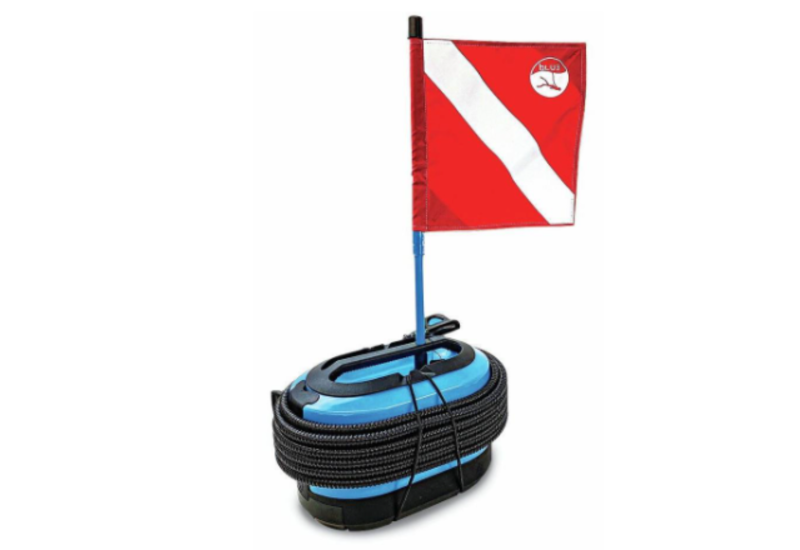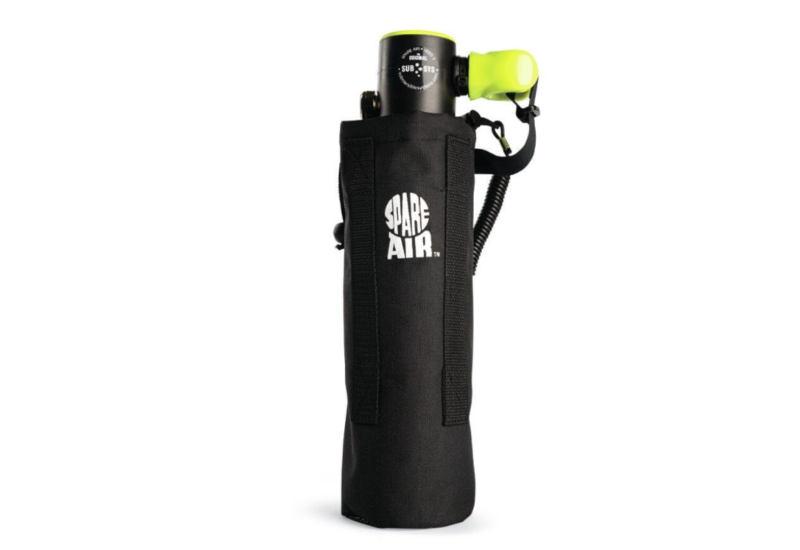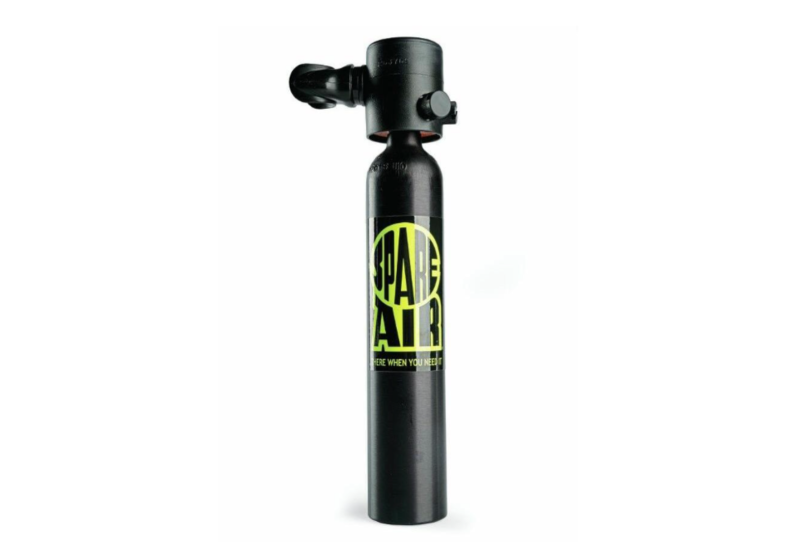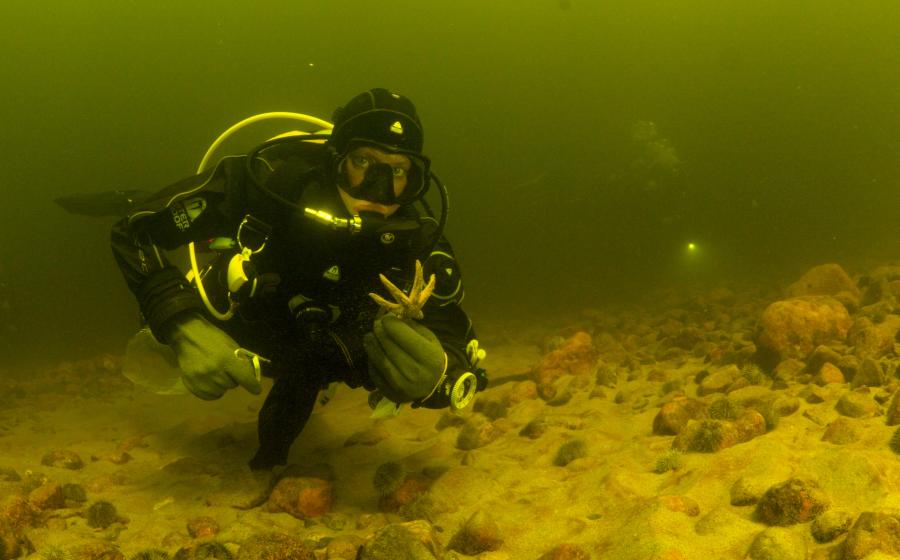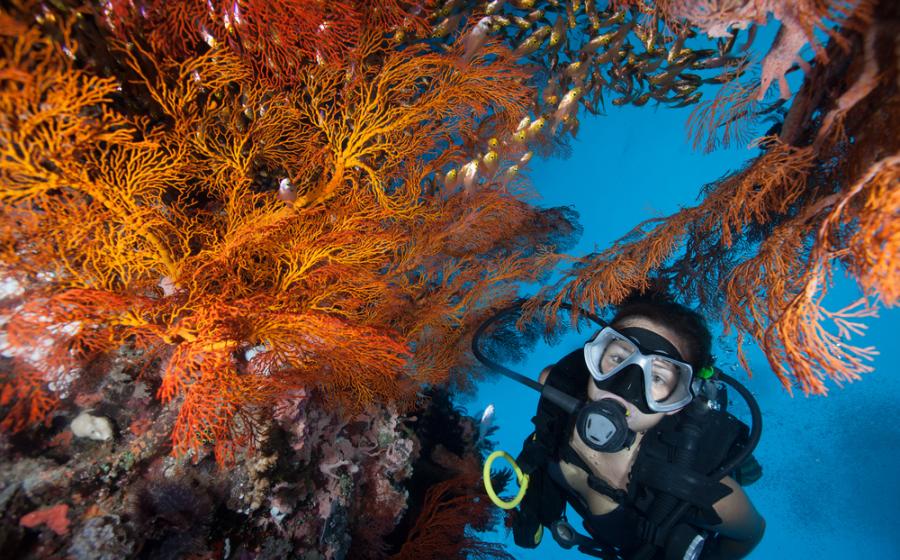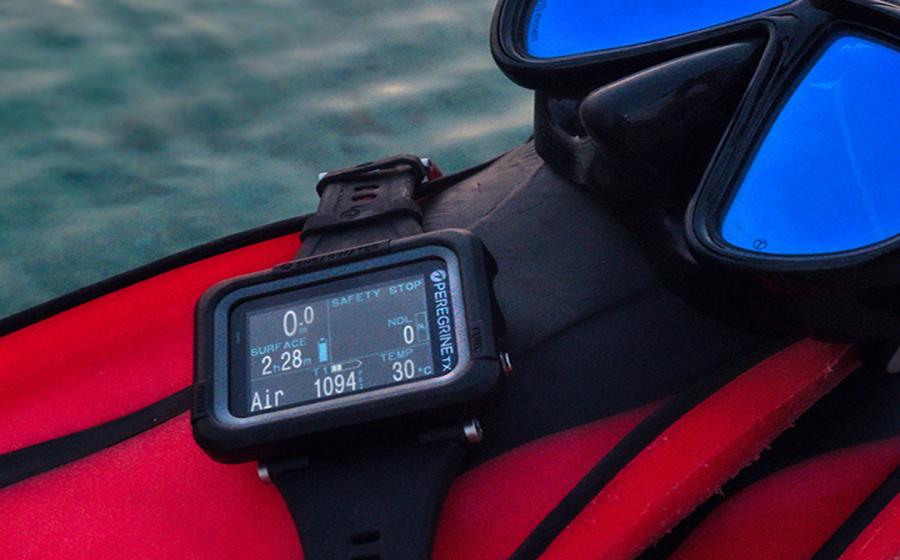The Best Scuba Regulators Under & Over $500 Tested by ScubaLab
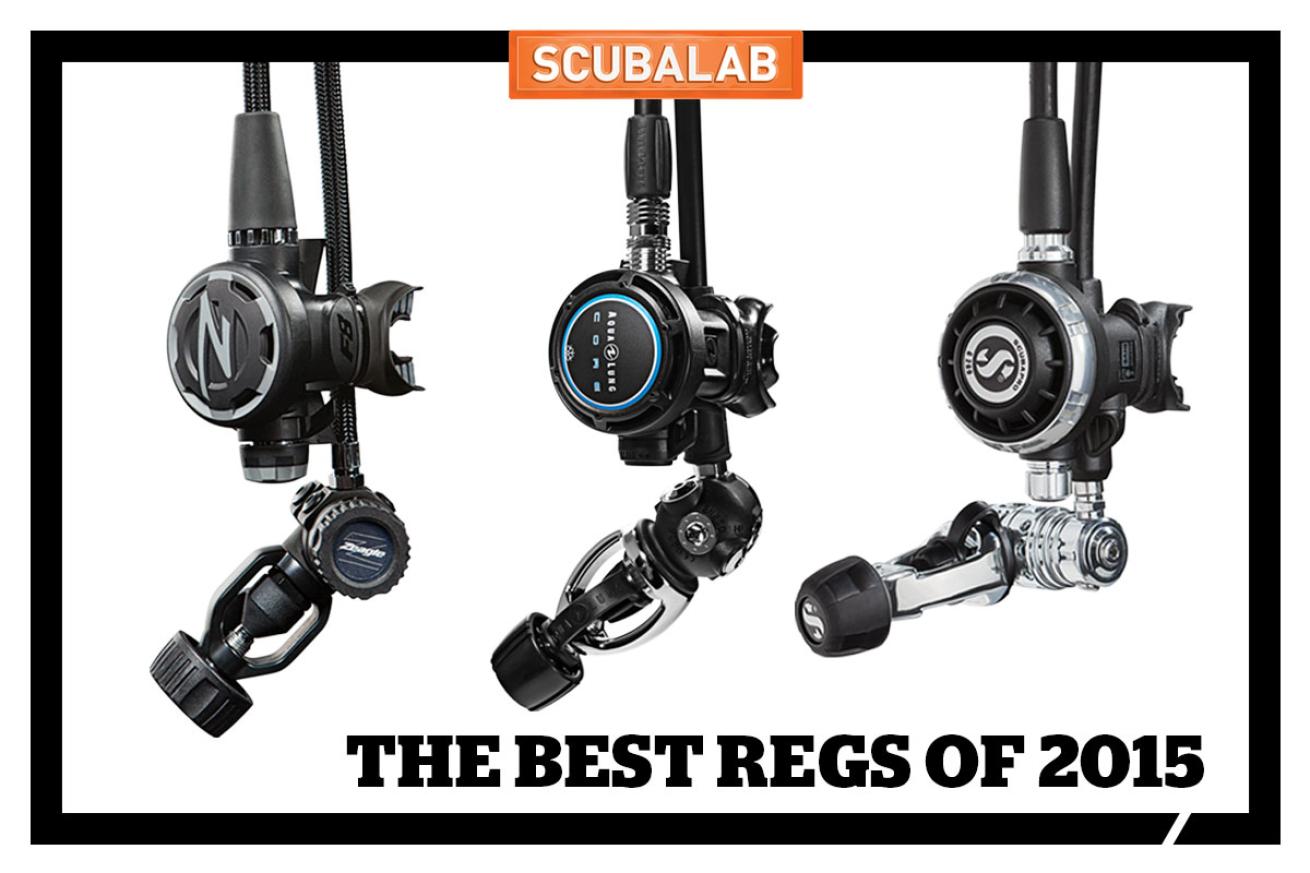
Photo Illustration by Scubadiving.comScubaLab Regulator Test 2015
CLICK HERE FOR THE LATEST REG REVIEW
ScubaLab tested 14 new regs — over and under the $500 price point — in an ANSTI breathing simulator and in the water. Find out how they stacked up in this year's regulator review.
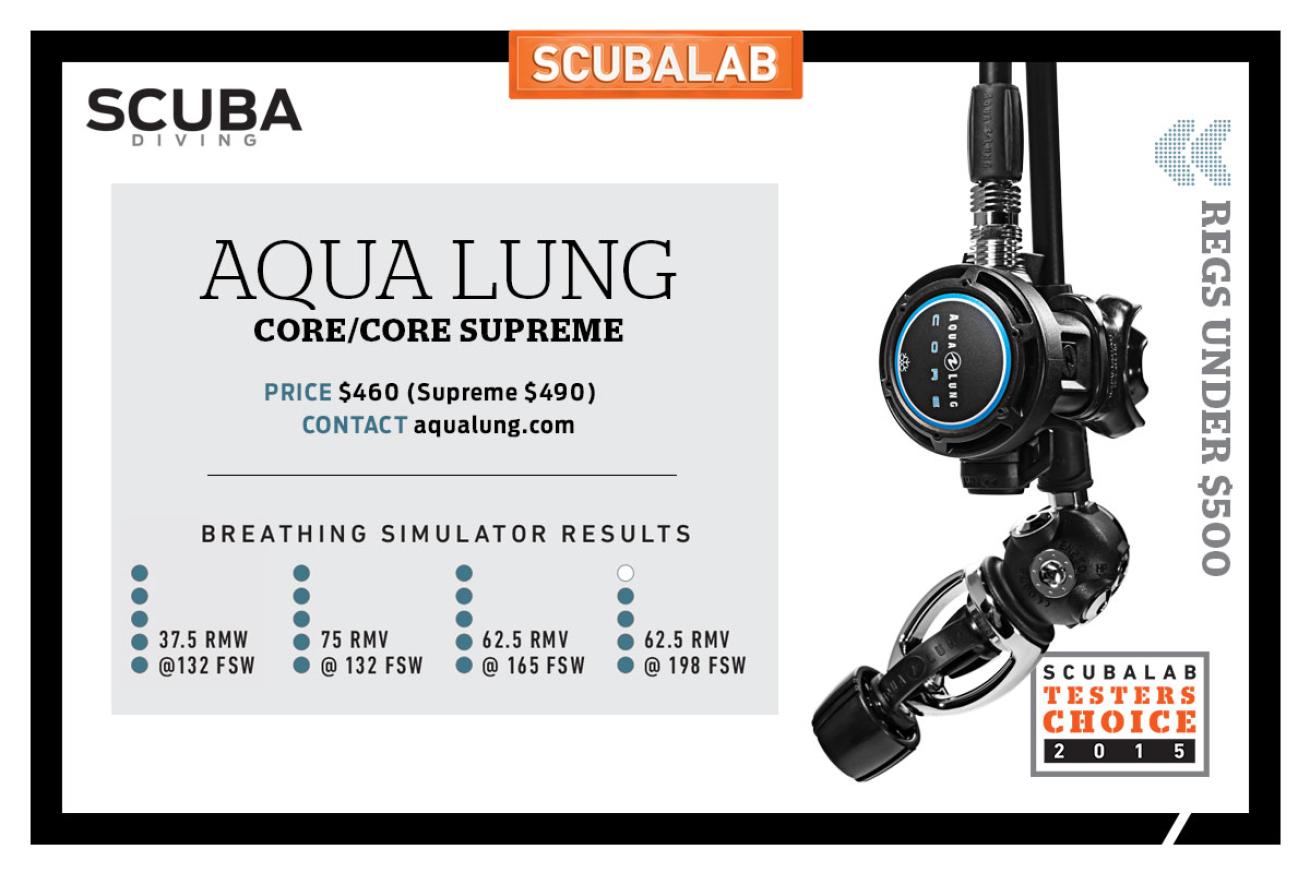
Photo Illustration by Scubadiving.comAQUA LUNG CORE/CORE SUPREME
TESTERS CHOICE — AQUA LUNG CORE/CORE SUPREME
PRICE $460 (Supreme $490)
Aqua Lung’s new midrange reg is available in two versions, the regular and the Supreme, which is rated for use in water 50 degrees below zero and comes with an environmentally sealed first stage. Otherwise the two versions appeared identical to us (in ANSTI machine testing they recorded the same intermediate static pressures down to /10 of a psi). Like the other regs in this price range, the Cores’ only user control is a Venturi lever, which divers found well positioned and easy to grip with or without gloves, and rated good for blocking free-flows (although some divers would have preferred the “MIN” and “MAX” markings on the rounded portion of the lever to be located on the top of the second stage, where they would be more visible). In ergonomic tests the Cores racked up top scores, and were also at the top of the pack in ANSTI machine testing, where they were the only regs in this price category to be rated excellent throughout the range-of-breathing rates and depths. The Aqua Lung Core/Core Supreme regs are our Testers Choice.
CONTACT aqualung.com
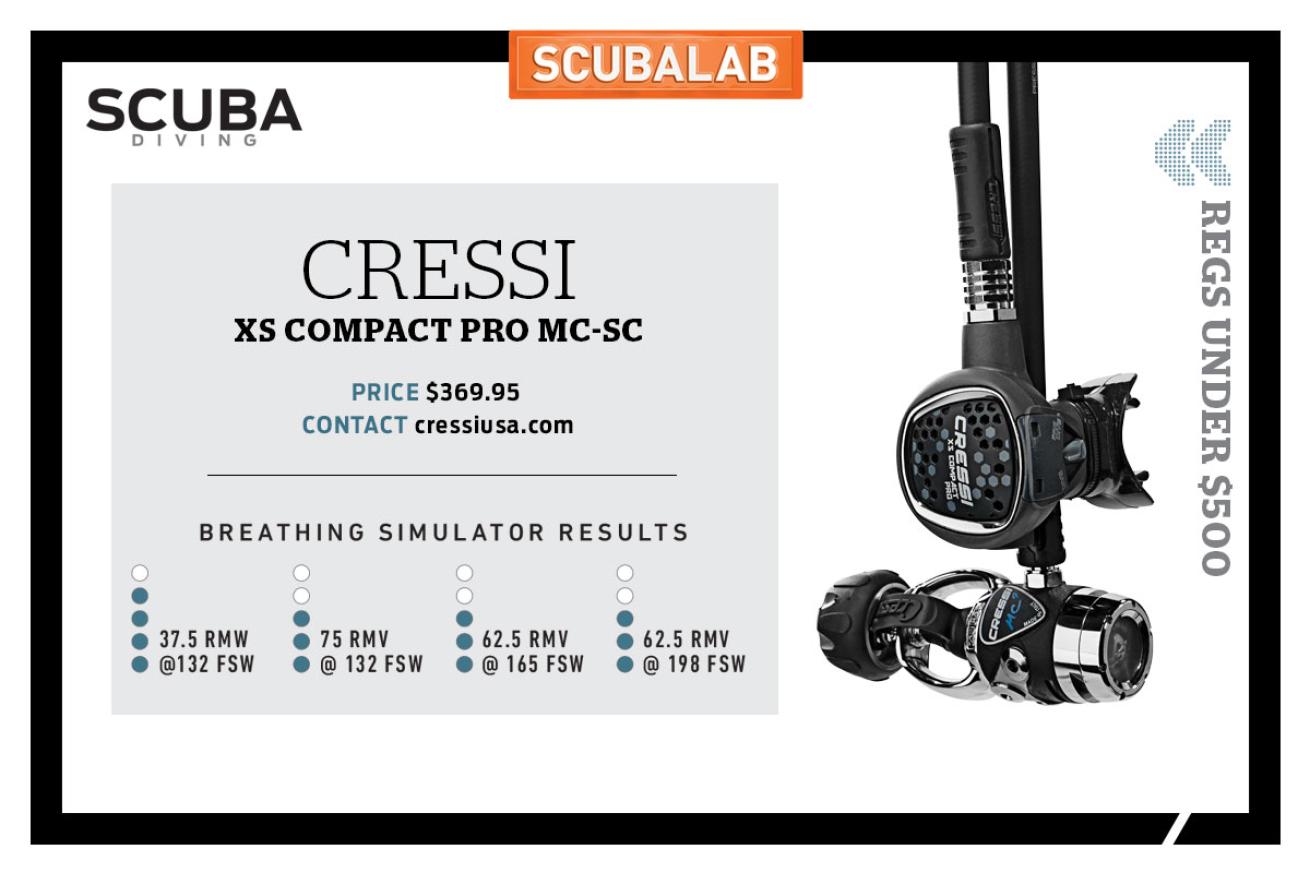
Photo Illustration by Scubadiving.comCRESSI XS COMPACT PRO MC-SC
CRESSI XS COMPACT PRO MC-SC
PRICE $369.95
The XS Compact was one of our divers’ favorites in last year’s ergo test, thanks to its really tiny, lightweight second stage, which was easy on the jaw. The Compact’s latest version maintains the trim profile of the second stage but pairs it with an environmentally sealed MC9- SC (for “sealed chamber”) first stage rated for cold-water use. Otherwise the latest version has all the attributes that we liked last year: a large, soft, easy-touch purge cover, and a Venturi switch that’s well marked and located on the top of the mouthpiece, where it’s easy to reach and operate. Divers rated the reg very good for ease of breathing in a swimming position, for dry breathing in normal positions and for ease of clearing (though some divers found it a bit wetter when head-down). On the ANSTI machine, the XS Compact’s performance was rated very good at max recreational depth and good down to our test limits.
CONTACT cressiusa.com
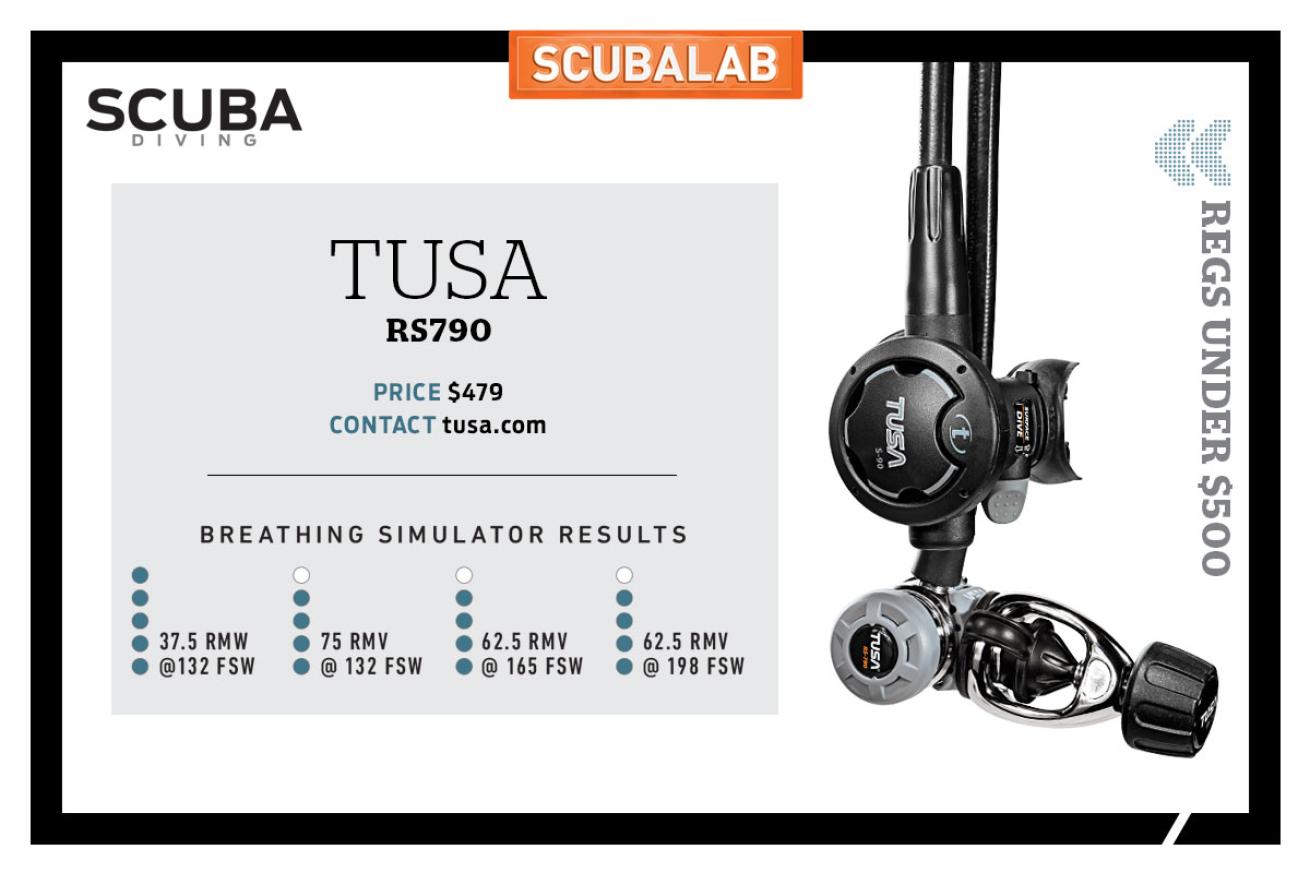
Photo Illustration by Scubadiving.comTUSA RS790
TUSA RS790
PRICE $479
The RS790 has a sealed first stage rated for cold-water use in which two of the four low-pressure ports (marked by “HFP”) are designed to deliver up to a 15 percent increase in airflow. In ANSTI machine testing the RS790 demonstrated excellent performance at a normal breathing rate at recreational depth, and very good performance to the limits of our test depths and breathing rates (and also reached one of the greatest depths of any reg in this category without breaking test parameters, even at an extremely high breathing rate). The second stage is light enough to be quite comfortable in the mouth. The purge cover is soft and large enough that it’s easy to reach and operate, but several divers found it a bit too strong, requiring a careful touch to avoid an unwanted blast of air. While there’s only about 1⁄8 of a turn in the Venturi lever, the settings proved just right, with surface free-flows curtailed and easy breathing at depth.
CONTACT tusa.com
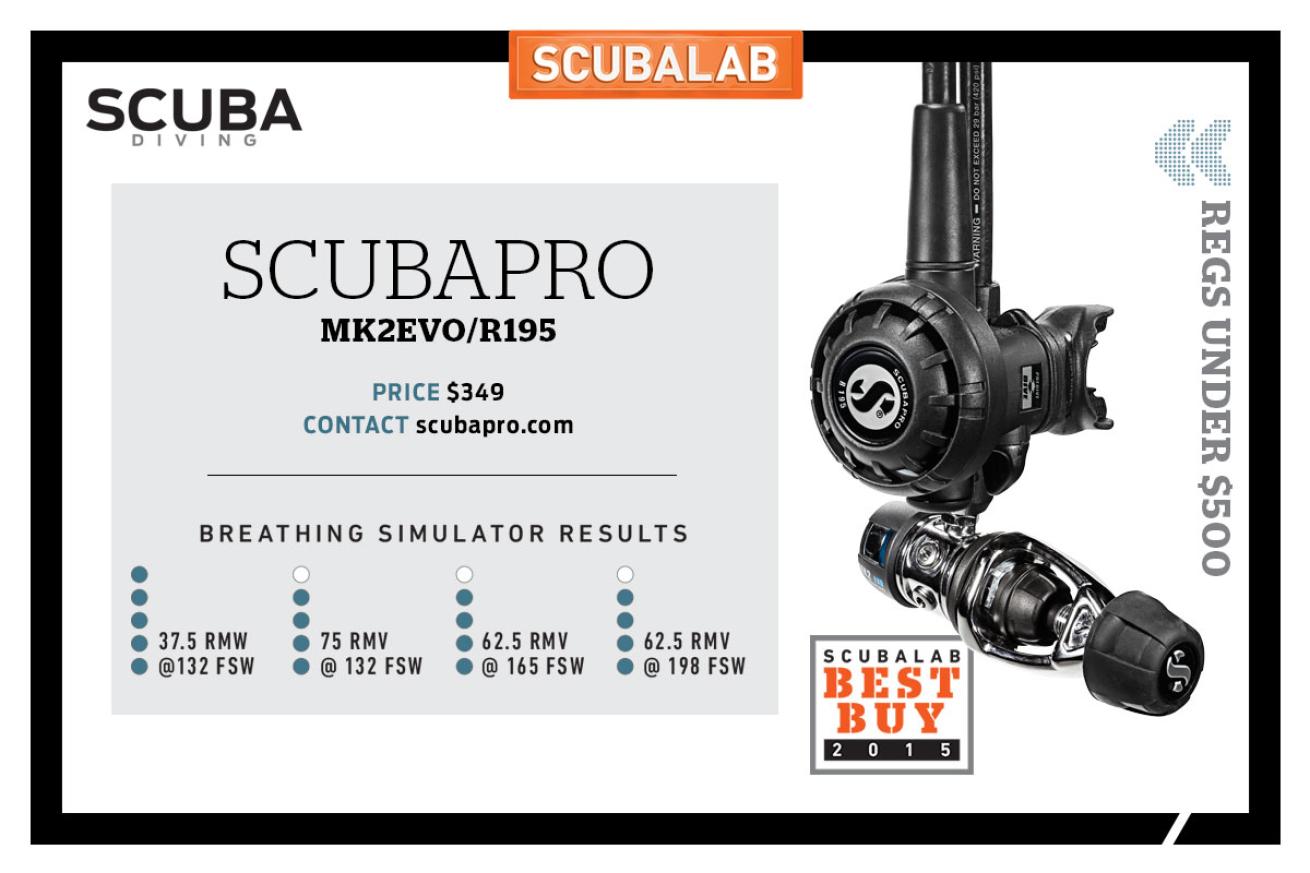
Photo Illustration by Scubadiving.comSCUBAPRO MK2EVO/R195
BEST BUY — SCUBAPRO MK2EVO/R195**
PRICE $349
Scubapro introduced the MK2 first stage back in 1963, and since then (with many updates) it’s earned a reputation for smooth performance and the reliability of an anvil. In its latest EVO incarnation, a smaller body houses a larger piston for more-sensitive response, and it’s rated for cold water. The second stage is also a venerable design, being the latest version of what began as the R190 more than 20 years ago. But nothing about this reg’s performance is old-fashioned. In ANSTI tests it was rated excellent at recreational depth, and very good throughout the range of depths and breathing rates. Test divers were impressed with its easy breathing. “Smooth as silk” and “no effort required” noted test divers. Some divers found the purge too zealous, and we didn’t like the way the first stage’s single high-pressure port limits hose-routing options. But for the price, this reg offers admirable performance, making the MK2 EVO/R195 our Best Buy.
CONTACT scubapro.com
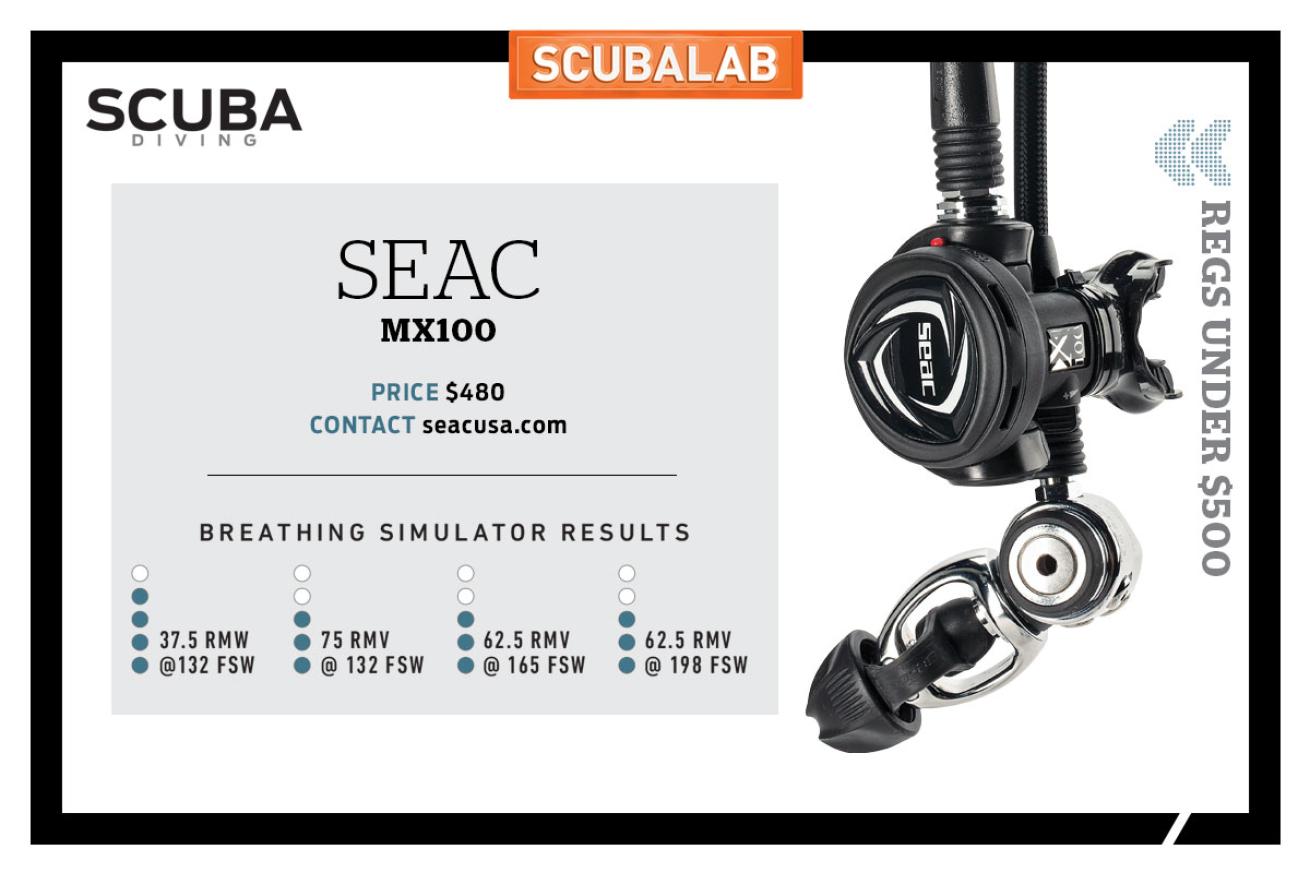
Photo Illustration by Scubadiving.comSEAC MX100
SEAC MX100
PRICE $480
The nicely finished MX100 has lustrous chrome on the first stage, a braided hose, and an abrasion-resistant finish on the purge cover. The large, triangular purge cover is rigid and a little stiff in the center, but just a touch along one of the corners clears the reg easily. Divers rated the MX100 very good for ease of breathing in a swimming position, and for dry breathing in both normal and head-down positions, tying the top scores in those categories. In ANSTI testing, the MX100 performed very good at recreational depth and good to the depth limits of the test. Test divers found the Venturi lever well marked, effective and easy to operate, even though it’s small and tucked in out of the way. The exhaust ports on the MX100 are quite short and curve in along the bottom, which helps make the second stage very compact and light but also seemed to allow a little extra bubble interference noted by some divers when vertical, although it wasn’t noticeable when in a swimming position.
CONTACT seacusa.com
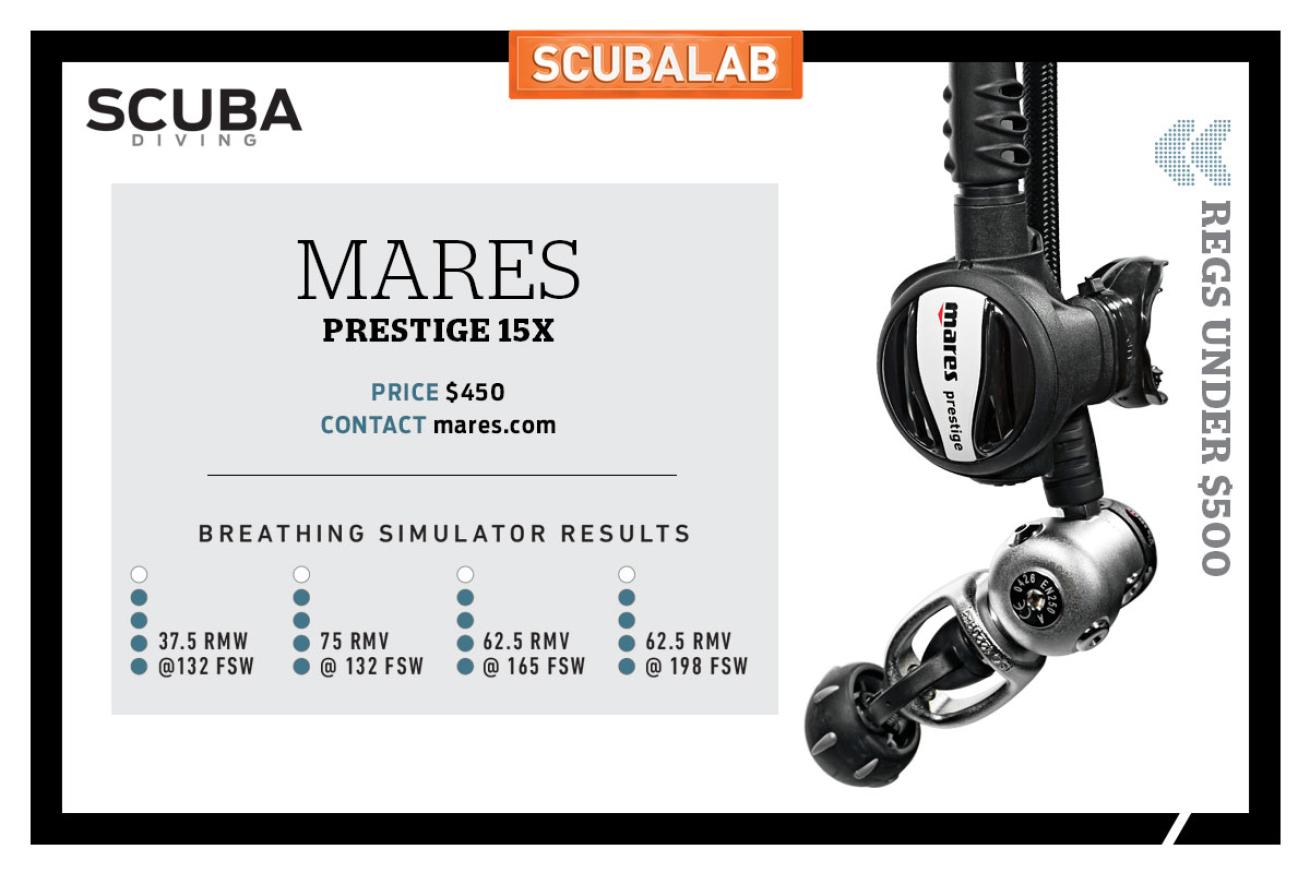
Photo Illustration by Scubadiving.comMARES PRESTIGE 15X
MARES PRESTIGE 15X
PRICE $450
The Prestige was the only reg in our test with no dive/predive switch, but like all modern regs, it uses the Venturi effect to reduce the effort needed to keep the diaphragm open when inhaling. The Prestige does this by way of an angled tube on the right side of the second stage leading to the mouthpiece inlet; it’s an air by- pass that creates a low-pressure vortex behind the diaphragm. It’s a simple design and, our testing showed, an effective one. In ANSTI tests the Prestige recorded very good scores across the board, and in ergonomic testing divers reported no more tendency to free-flow at the surface than any of the other regs in the test. Divers rated the Prestige very good for ease of breathing in swimming position, ease of clearing and dry breathing, although some noted it breathed a bit wetter when head-down. Divers liked the second stage’s light weight, its braided hose and its purge-cover design, which is effective and easy to use even when wearing gloves.
CONTACT mares.com
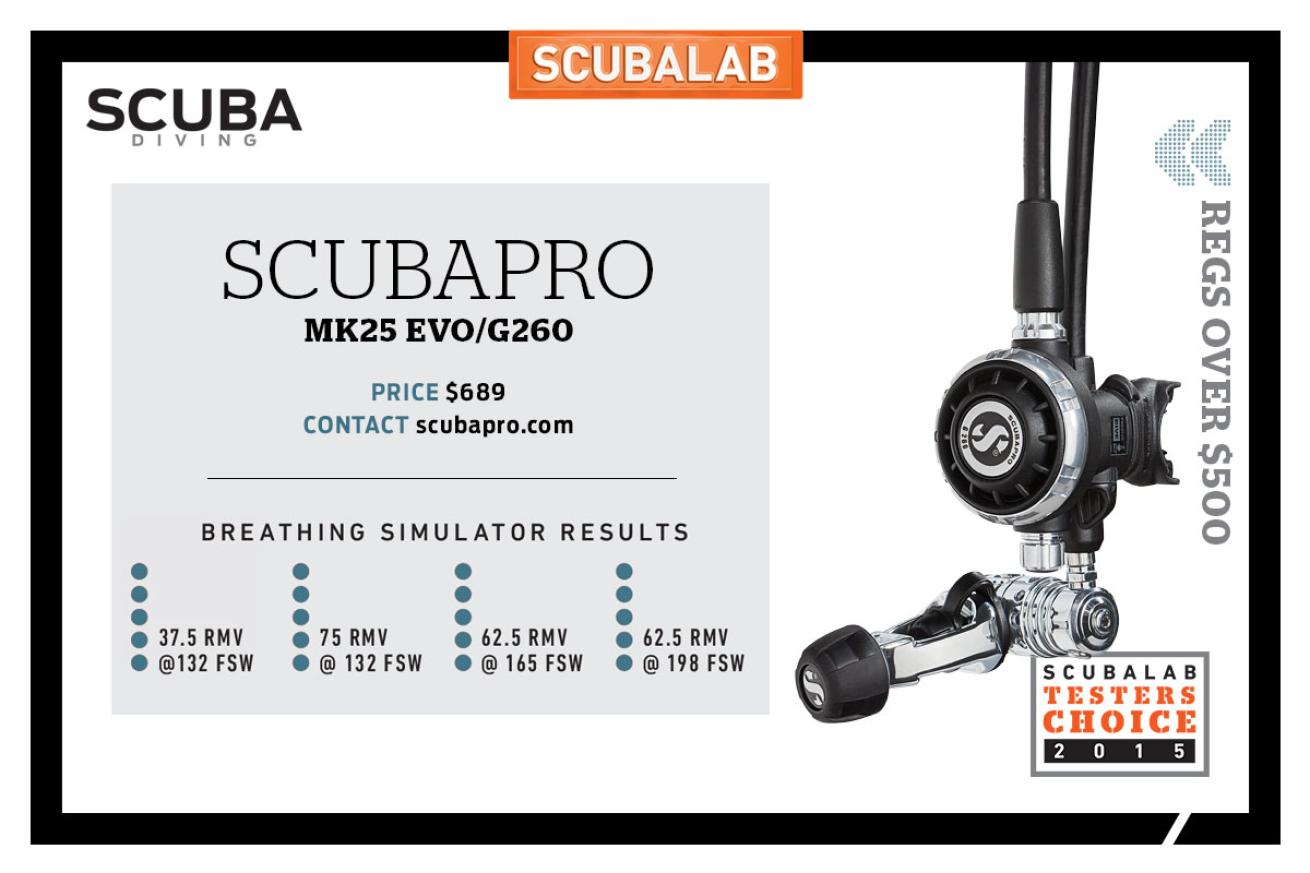
Photo Illustration by Scubadiving.comSCUBAPRO MK25 EVO/G260
TESTERS CHOICE — SCUBAPRO MK25 EVO/G260
PRICE $689
With its rugged, matte-black-and-metal second stage and performance cred, this reg gives of a “just-for-techies” vibe. It backed that up in our ANSTI testing, chalking up excellent ratings at all depths and breathing rates, recording the lowest work-of-breathing scores at recreational depth, and delivering air within our test parameters, even at a torturous 75-liter-per-minute breathing rate down to 240 feet — the deepest of any reg in our test. But test divers found nothing muscle-bound about its in-water performance, where it earned comments including “super smooth” and “like butter!” Divers liked the reg’s effective Venturi and breathing-adjustment controls, and its just-right purge, but what they loved was that smooth, effortless breathing. It tied the high ergonomic scores in every category except head-down position, where divers rated it just good for ease of breathing and dry air. It also made its way onto more divers’ top-three- favorites lists than any other reg in the test. The MK25 EVO/G260 is our Testers Choice.
CONTACT scubapro.com
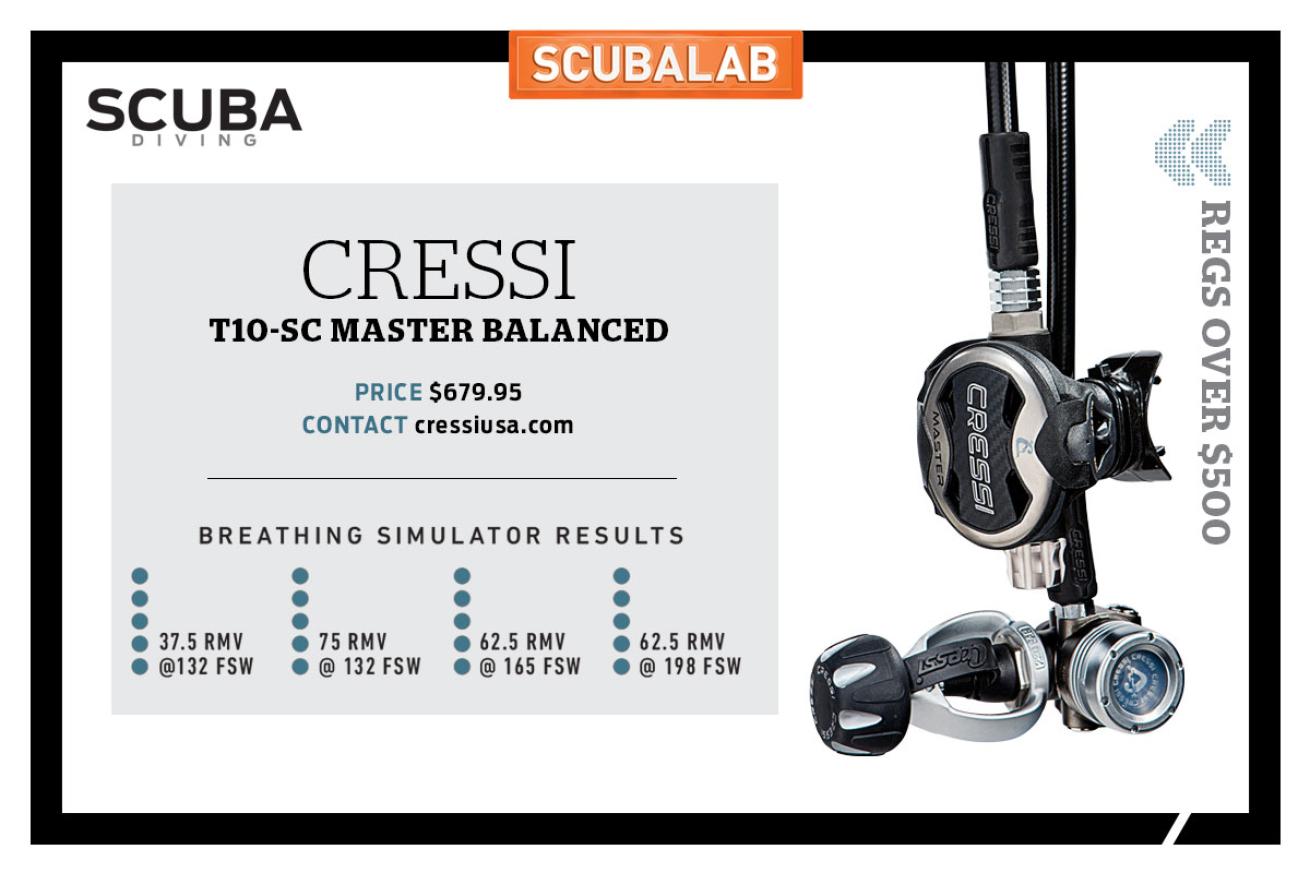
Photo Illustration by Scubadiving.comCRESSI T10-SC MASTER BALANCED
CRESSI T10-SC MASTER BALANCED
PRICE $679.95
The SC designation on this model of the new T10 stands for “sealed chamber,” signifying the environmentally sealed diaphragm first stage that's rated for cold water. The T10’s second stage has a wide, elliptical diaphragm with a titanium trim piece around the purge and a large, knurled, metallic breathing-adjustment knob. All that metalwork gives it a somewhat beefy look, but test divers found that the second stage is actually quite lightweight and easy on the jaw. Test divers rated it very good for ease of breathing in swimming position, dry-air delivery in any position, ease of clearing, and effectiveness of the breathing adjustment, which divers found easy to dial in thanks to that oversize, grippy knob. Some divers found the wide, narrow purge cover somewhat stiff and thought it required a little getting used to, but they also noted it didn’t free-flow even in strong current. In ANSTI testing, the T10 proved one of the top performers in our test, racking up excellent scores for ease of breathing at all depths and breathing rates.
CONTACT cressiusa.com
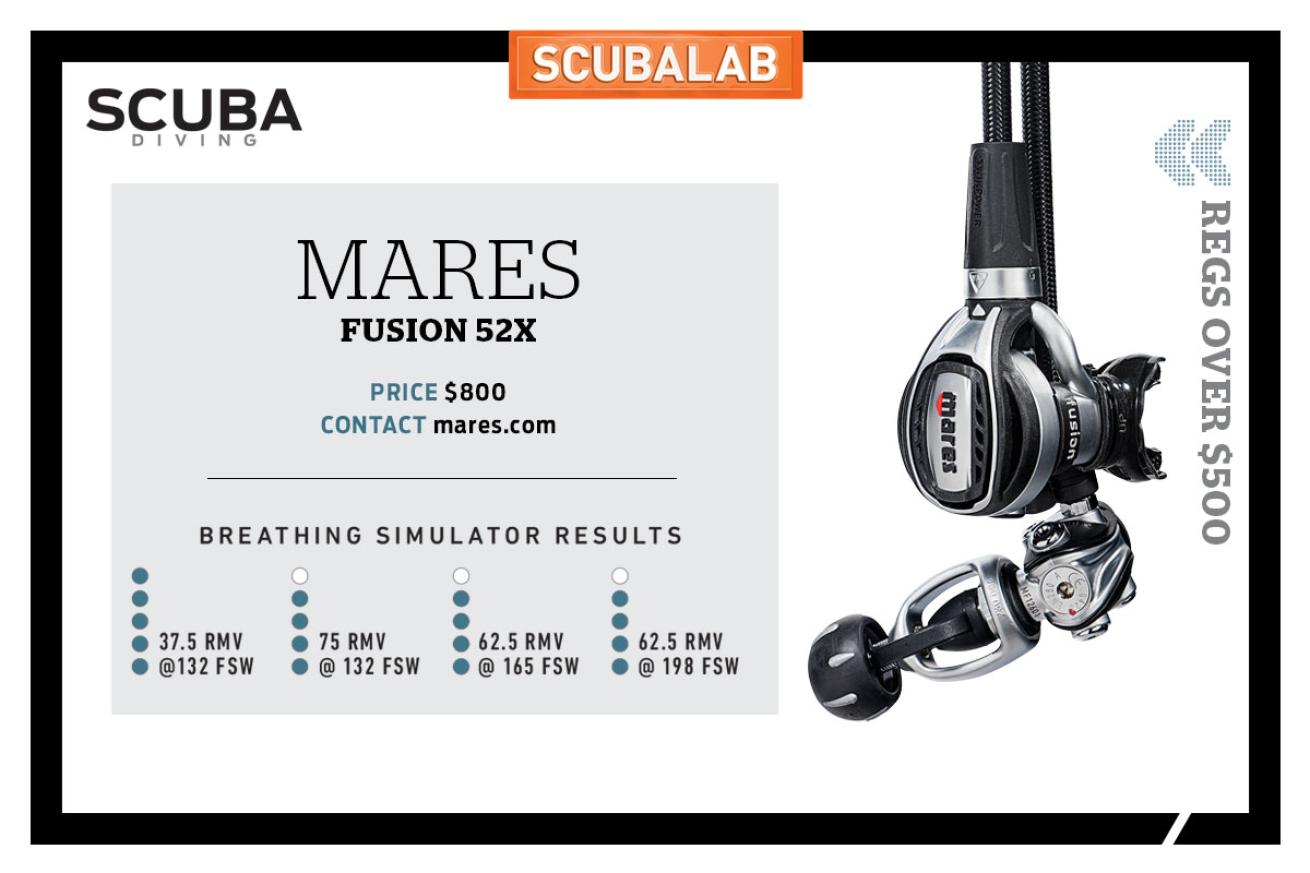
Photo Illustration by Scubadiving.comMARES FUSION 52X
MARES FUSION 52X
PRICE $800
Mares calls this “a radical departure” from other regs, and you'll hear no argument from us. The Fusion's unique design elements include the long, curved air-bypass tube to the mouthpiece, a purge cover that’s hinged like a trap door, and a rotating air control on the hose fitting that the manual says “works like a motorcycle throttle” — twist forward for less, back for more. Performance in ANSTI testing was impressive, with the Fusion 52X recording one of the lowest work-of-breathing scores for an excellent rating at recreational depth, and very good scores to our test limits. The reg is novel enough that test divers found that it took a bit of getting used to. Some divers loved the air control, which, when wide open at depth, seems to deliver air almost before you draw in your breath. Others found wide open too pushy and preferred to back of the throttle. Likewise the purge: It feels odd at first, but with a little use, you’re able to use it very precisely. The more we used this reg, the more we liked it.
CONTACT mares.com
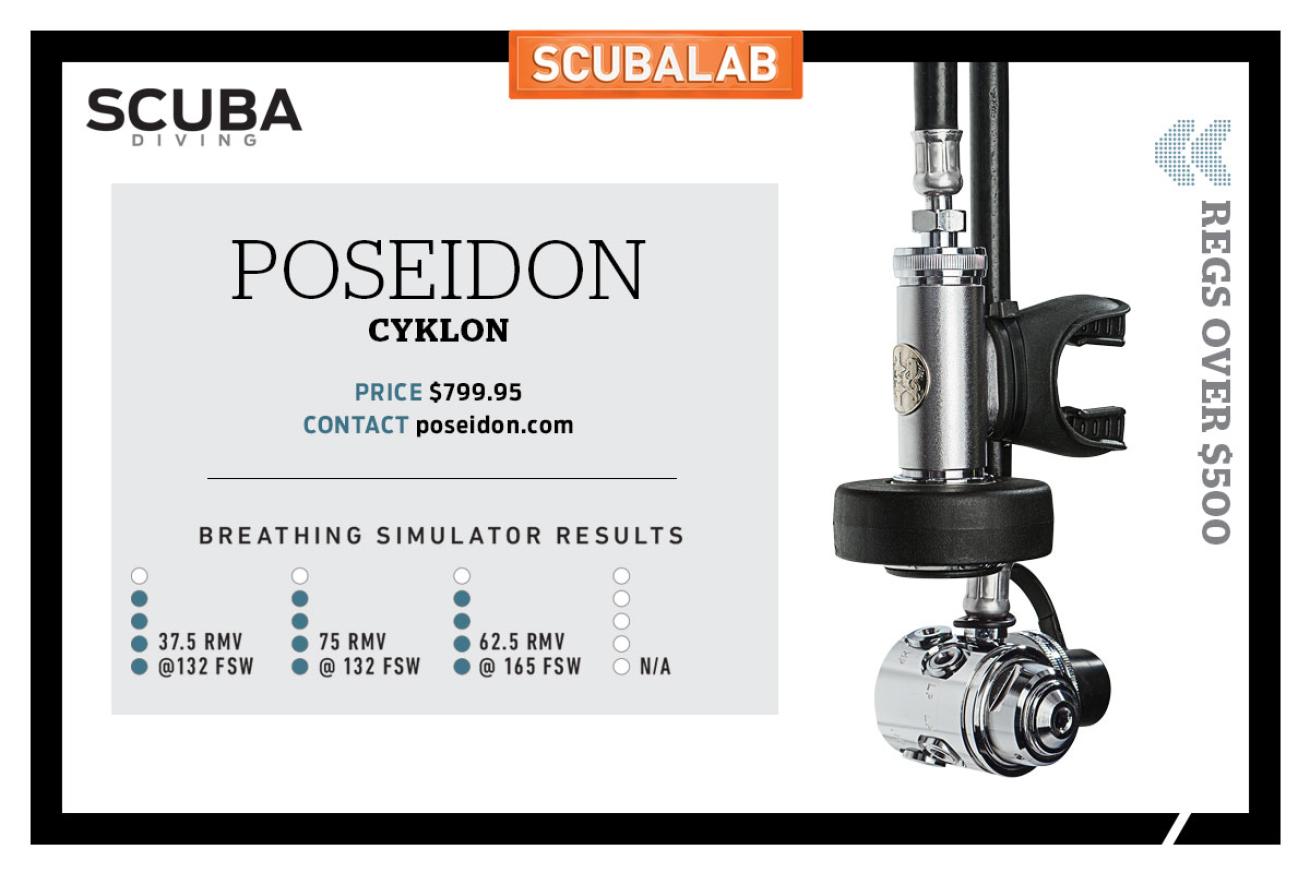
Photo Illustration by Scubadiving.comPOSEIDON CYKLON
POSEIDON CYKLON
PRICE $799.95
The side-exhaust Cyklon was launched during the Eisenhower administration, with nonstop updates ever since. Like its sibling the Xstream, it can be used on either the left or right side. We tested the latest version of the Cyklon Metal (the Cyklon 5000 has a plastic second stage), which, with its mix of shiny and matte metalwork and large, black diaphragm end cap, has a vintage look that verges on steampunk. In ANSTI testing, the Cyklon scored a rating of very good at recreational depth. But it was in the water that the Cyklon really shined, proving to be one of the test divers’ favorites, tying the top ergonomic scores across the board and making it to multiple divers’ top-three lists. Divers rated it especially highly for ease of breathing and dry breathing in all positions, and they liked the purge placement — which is straight rather than angled toward the rear as on the Xstream. Despite the metalwork and large diaphragm housing, the second stage is lighter than it looks, making it surprisingly comfortable.
CONTACT poseidon.com
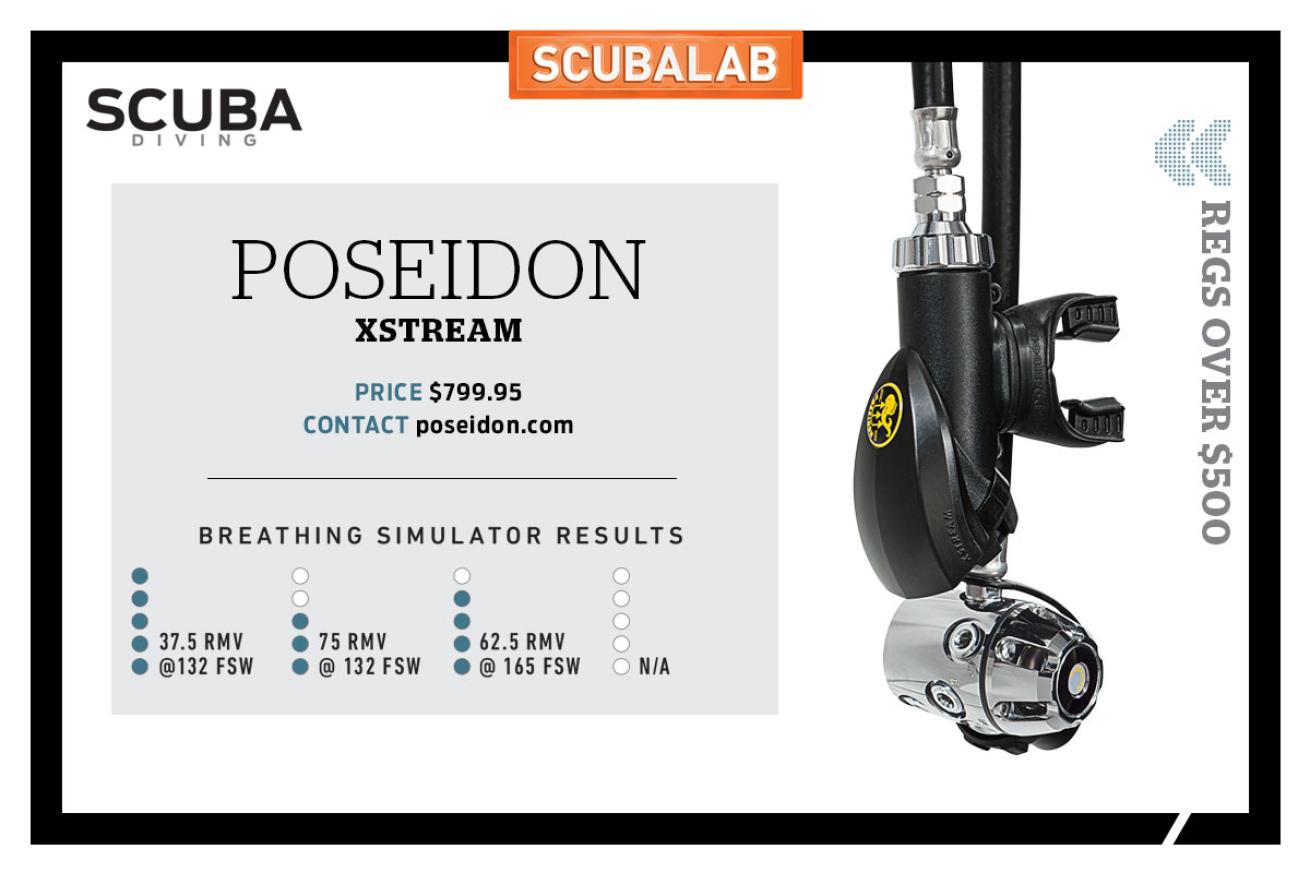
Photo Illustration by Scubadiving.comPOSEIDON XSTREAM
POSEIDON XSTREAM
PRICE $799.95
The tec-oriented Xstream is currently one of only two regs approved by the U.S. Navy for cold-water use (the Mares Abyss Navy II was the first regulator approved for cold-water use under the new standards). The first stage of the Xstream uses a design that Poseidon says reduces potential failure points by two-thirds. The Xstream has no adjustments, but test divers reported no issues with free-flows. The second stage is compact and easy on the jaw, and with its side exhaust, it works on either side (perhaps why it was rated one of the driest regs in head-down position). Divers also rated it very good for bubble interference. But while the second stage is ambidextrous, the purge is less so. Located opposite the hose and angled toward the back, it can only be easily pressed with the hand on that side, and a careless jab will kick of a blast of air that some test divers found too forceful (though a benefit of the design is it won’t free-flow in a strong current or on a fast scooter.) In ANSTI testing, the Xstream earned an excellent rating at recreational depth, recording one of the lowest work-of-breathing scores in our test.
CONTACT poseidon.com
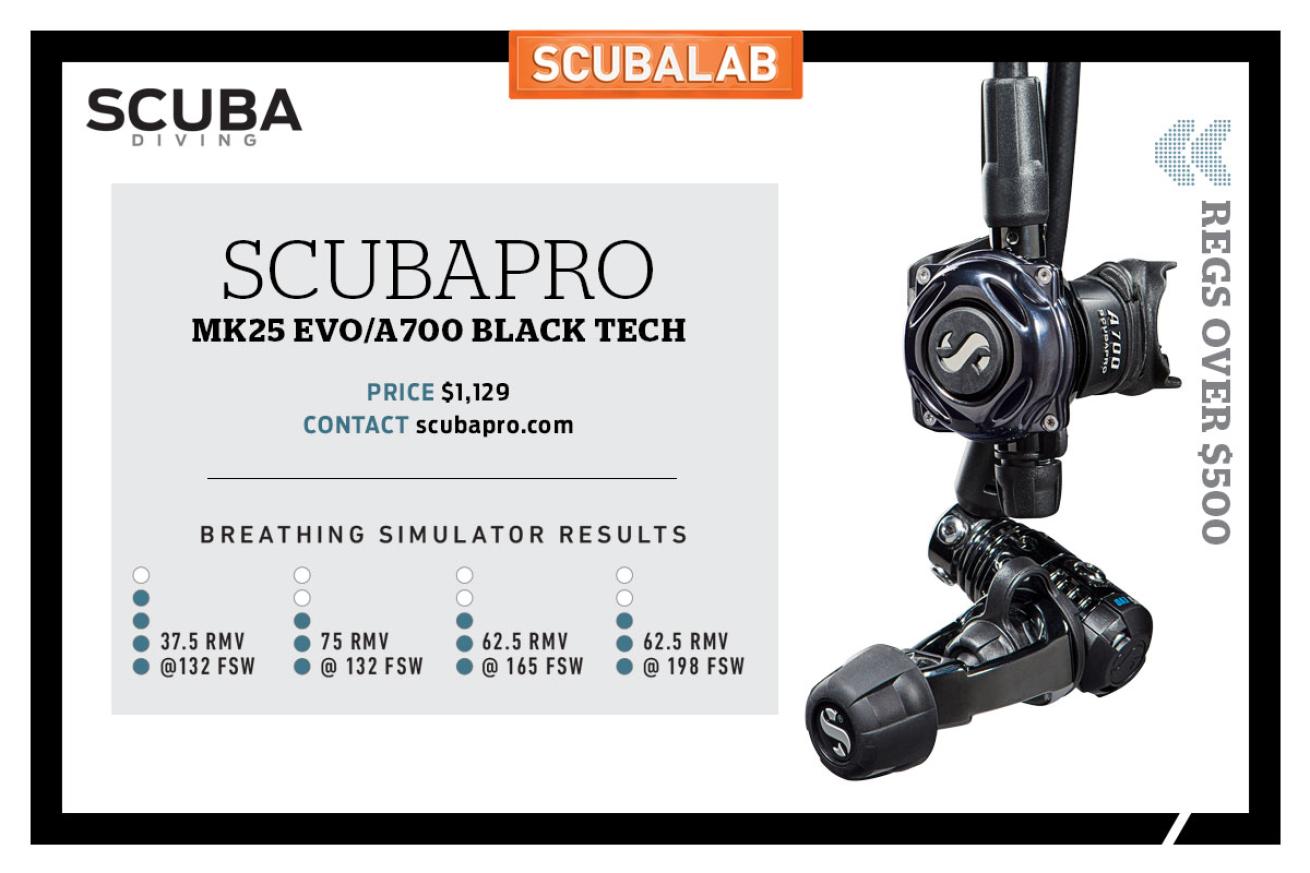
Photo Illustration by Scubadiving.comSCUBAPRO MK25 EVO/A700 BLACK TECH
SCUBAPRO MK25 EVO/A700 BLACK TECH
PRICE $1,129
Paired with Scubapro’s flagship piston first stage — the MK25 EVO, rated for cold-water use — the A700 second stage has also gotten a makeover with the Black Tech finish, a lustrous coating resistant to abrasion and corrosion. The cool finish and metal diaphragm cover give it a tough, all-business look. The reg proved capable on the ANSTI machine, where it was rated very good at recreational depth and good to test limits. Test divers rated it good for easy, dry breathing regardless of position. The Venturi lever was effective, if a little stiff. Divers also found the breathing-resistance adjustment effective, earning it a very good rating. However, some divers said the adjustment needed tuning more frequently than they liked, with relatively small changes in depth or breathing rate requiring a touch of the knob. Divers also thought the reg was noisier than average on intake, with a few finding the noise bothersome. But they liked the swiveling first-stage barrel and five low-pressure ports, which give a wide choice of hose-routing options.
CONTACT scubapro.com
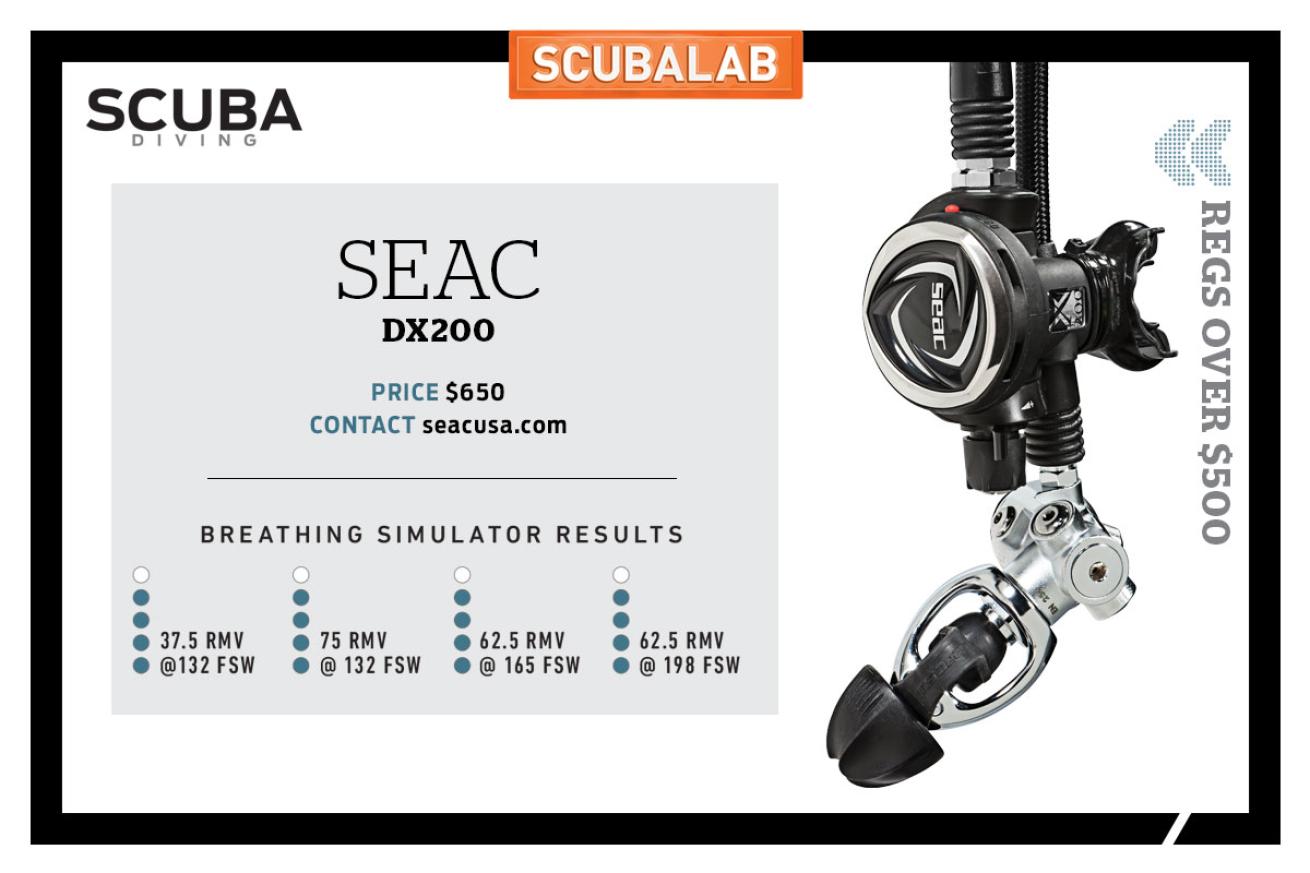
Photo Illustration by Scubadiving.comSEAC DX200
SEAC DX200
PRICE $650
On some regs, the breathing adjustment doesn’t seem to make much difference, but the new DX200 isn’t one of them. With more than three full turns of adjustment, changes made a big difference, allowing test divers to dial in performance and helping the DX200 earn a very good score for ease of breathing and effectiveness of adjustment. Divers found the Venturi control well marked, easy to operate and effective at blocking free-flows. The DX200’s purge cover is a large, rounded triangle that allows good control — a gentle push on one of the corners provides an easy clearing of the reg without an overly strong blast — although some divers thought it required more movement than it should have. The glossy purge cover and satin-finish metal surrounding it give the reg a refined appearance. In ANSTI testing, the DX200 was rated very good across the board at all test depths. The barrel on the balanced diaphragm first stage doesn’t swivel, but the four low-pressure ports are angled at 20 and 30 degrees for additional hose-routing options.
CONTACT seacusa.com
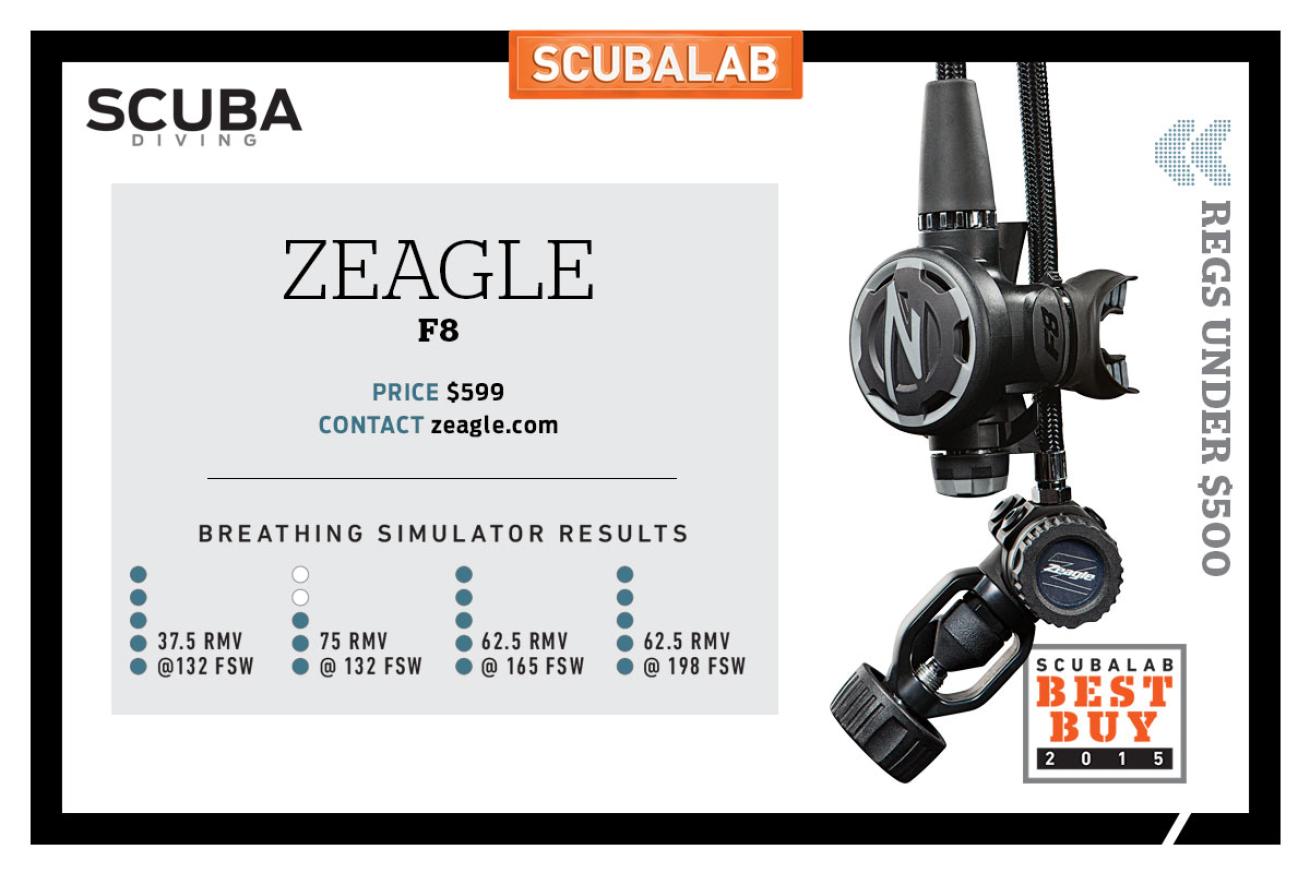
Photo Illustration by Scubadiving.comZEAGLE F8
BEST BUY — ZEAGLE F8
PRICE $599
Zeagle’s new flagship reg links to the company’s heritage (“F8” is a nod to the long-running Flathead reg series), but with a different look and feel oriented as much toward comfort as performance. The second stage is compact and light, with smooth edges and soft parts. The purge cover, which takes up the whole front of the reg, is soft and rubbery, the breathing adjustment knob is a full inch in diameter and ringed with soft rubber, and the Venturi lever is one of the easiest to reach and operate we’ve used (and is clearly marked). Where the sprocket-like heat sink connects to the second stage, fingers are protected from scrapes by the wide, soft hose cover. Divers noticed this attention to ergonomics, and that earned the F8 top ergonomic scores in our test. It prompted test-diver comments such as “all around comfortable to use” and “everything you would want in a reg.” Our ANSTI testing showed the F8 was giving up nothing in performance for the comfort, and doing it for the lowest price here, making the Zeagle F8 our Best Buy.
CONTACT zeagle.com
HOW WE SCORE
ANSTI breathing simulator results shown here are based on a score of 1 to 5, where 5 represents excellent performance with work-of-breathing measurements of 1 joule per liter or less at carefully regulated depths and breathing rates and volumes.
HOW WE TEST
ScubaLab put these regs through two tests — the first is conducted on a breathing simulator (objective), and the second by our team of test divers (ergonomic).
OBJECTIVE TESTING
We conducted tests on an ANSTI wet breathing simulator at Dive Lab, a commercial test facility in Panama City Beach, Florida. The simulator measures the effort (work of breathing) required to move air through a regulator as it is subjected, under- water, to a precise series of depths and breathing rates.
The simulator pressurizes the test chamber to simulate depths of 132 fsw, 165 fsw and 198 fsw. Each “breath” by the machine moves 2.5 liters of air through the regulator, at breathing rates of 15, 25 and 30 breaths a minute. These precisely measured volumes of air — 2.5 liters multiplied by the breathing rate — are called Respiratory Minute Volumes (RMVs).
37.5 RMV @ 132 fsw:
This represents the maximum recreational depth at a somewhat aggressive breathing rate.
75 RMV @ 132 fsw:
This simulates the potential demand at maximum recreational depth for a diver at an extremely heavy work rate, or loosely simulates two divers buddy breathing at a somewhat aggressive rate.
62.5 RMV @ 165 fsw:
This represents the European conformance standard EN250, and is also the depth and breathing rate commonly used by manufacturers when determining a regulator’s performance.
62.5 RMV @ 198 fsw:
This is the U.S. Navy’s Class A test depth and breathing rate (although the Navy uses a higher HP supply pressure than we do). The simulator monitors how much effort is required to breathe, measuring the work of breathing in joules per liter (j/l). In our ratings, a score of 1=3j/l or greater; 2 = 2.26-3.0 j/l; 3 = 1.51-2.25 j/l; 4 = 1.1-1.50 j/l; and 5=1j/l or less.
We don’t test on the simulator for a pass/fail grade, but to objectively gauge performance in carefully controlled conditions. You can see how each reg performed on the breathing simulator in the charts that accompany the reviews.
ERGONOMIC TESTING
We conducted these tests at Alexander Springs in Florida with a team of divers who recorded their scores during their dives using underwater slates and waterproof test sheets. Divers evaluated each regulator in 13 specific performance areas, assigning scores from 5 (excellent) to 1 (poor), and recording their observations and comments about factors that determine the comfort and performance of the reg while they were actually being used.
ERGO TEST CATEGORIES
1 Ease of breathing in swimming position
2 Ease of breathing in head-up position
3 Ease of breathing in head-down position
4 Wetness in normal swimming position
5 Wetness in head-down and odd positions
6 Bubble interference in normal swimming position
7 Bubble interference in vertical/stationary position
8 Ease of clearing regulator using the blowing method
9 Ease of clearing regulator using the purge button
10 Purge button stiffness and comfort
11 Comfort of mouthpiece
12 Venturi lever adjustment function and effectiveness
13 Breathing- adjustment-knob function and effectiveness
WHAT YOU GET FOR UNDER $500
Regs in this price range tend to be short on frills. None we tested in this price category had breathing resistance adjustments, rotating first stages, swivel hose connections, titanium goodies, etc. In some cases, that means you’re giving up a bit of comfort or convenience, such as the additional options for hose routing that you get with a rotating first stage, or the ability to precisely fine-tune your reg’s breathing resistance at a particular depth and workload. But that’s not to say these regs cut corners when it comes to performance — in our testing some showed work-of-breathing scores on the ANSTI machine and comfort and ease of breathing in the ergo tests to rival regs with much heftier price tags. Of course, their lack of breathing resistance adjustments means it’s especially important that their factory presets strike the right compromise between too much and too little at varying depths and breathing rates. Our testing suggests they usually hit very close to the mark.
WHAT YOU GET FOR OVER $500
The regs we tested in this price range showed slightly higher performance overall on the breathing simulator than their thriftier brethren (principally at greater depths and extreme breathing rates). But testers found that some features on these regs added comfort and convenience. Breathing adjustments allowed fine-tuning airflow with changes in depth or breathing demands. Exotic materials helped keep components light for comfort without sacrificing performance or durability. And first-stage features like rotating barrels or extra ports provided more hose-routing options.
While our test-team divers were impressed with the performance of the $500-and-under regulators, they found that some of the extras that come with these pricier models really are well worth it.
Q: What makes a reg a favorite?
A: As you'd expect for a piece of gear as personal as a reg, test divers have varying opinions. But the regs our testers liked best had controls that were easy to use and effective (and well marked). They had second stages that were compact and didn't create bubble interference. They had purge controls that could clear the reg effectively without an excessive blast of air. And — above all else — they delivered smooth, quiet breathing, with as little effort as possible. — Roger Roy, ScubaLab Director
Our divers liked regs with a light-weight second stage, an easy, predictable purge, controls that are effective and easy to adjust, and smooth, steady breathing without a lot of noise.
REG CLEANING
Don’t just give your reg a quick rinse after diving — give it a good long soak, especially if you’ve done multiple dives in salt water. Always be sure to give clean, fresh water time to wash away any salt that has accumulated before it can cause corrosion or other damage to sensitive parts such as valves and diaphragms. If possible, soak your reg while it’s installed on a tank and pressurized, which will prevent water from getting inside. If it’s not pressurized, don’t press the purge while it’s soaking because that could let water inside.
No piece of dive gear is more important to keep in proper working condition than your reg. Inspect it carefully before every use, clean it thoroughly after diving, and have it serviced at intervals the manufacturer recommends.
PERFORMANCE YOU CAN SEE
The graphs below show results of ANSTI testing on the same reg at different depths and breathing rates. The loops go clockwise, starting at the right, as inhalation begins, and moving to the left, where exhalation starts. Below the centerline shows the negative pressure required to inhale; above shows the positive pressure needed to exhale, measured in millibars.

Photo Illustration by Scubadiving.comANSTI Breathing Rates for SCUBALAB
The top graph was taken at 132 feet at 15 breaths per minute, and recorded a work-of-breathing score of .73 joules per liter — excellent performance, showing it was able to deliver air at that rate and depth with little effort. The next graph shows the same reg at 181 feet and a breathing rate of 30 breaths per minute. The denser air, higher water pressure and rapid breathing are taxing the reg, pushing its work- of-breathing score to 1.76 joules per liter — good, but a difference a diver would feel.


